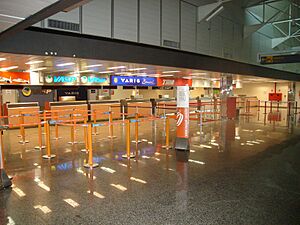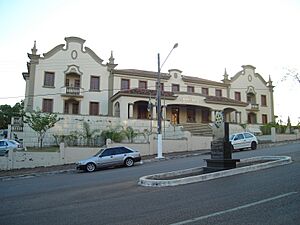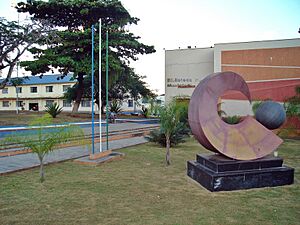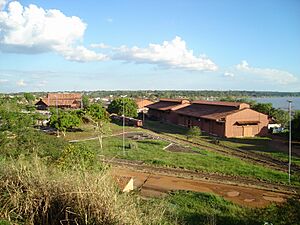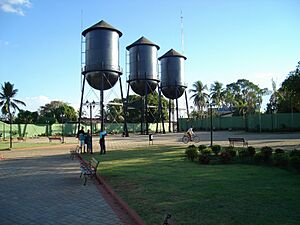Porto Velho facts for kids
Quick facts for kids
Porto Velho
|
|||
|---|---|---|---|
|
Municipality
|
|||
| Município de Porto Velho Municipality of Porto Velho |
|||
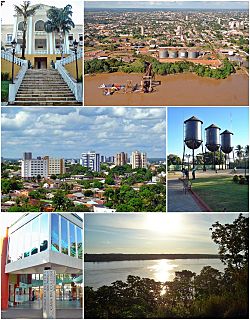
Top left:Rondonia State Government Office, Top right:Port of Porto Velho, Middle left:Porto Velho Cultural House, Middle right:Sunset in Madeira River, Bottom:Panorama view of downtown from Pedrinhas area
|
|||
|
|||
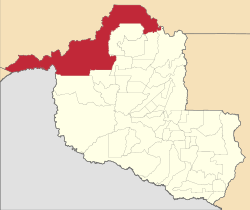
Location of Porto Velho in the State of Rondônia
|
|||
| Country | |||
| Region | North | ||
| State | |||
| Founded | October 2, 1914 | ||
| Area | |||
| • Total | 34,082.37 km2 (13,159.28 sq mi) | ||
| Elevation | 83 m (272 ft) | ||
| Population
(2021)
|
|||
| • Total | 548,952 | ||
| • Density | 16.106626/km2 (41.71597/sq mi) | ||
| Time zone | UTC−4 (AMT) | ||
| Postal code |
76800-001 to 76849-999
|
||
| Area code | +55 69 | ||
| HDI (2010) | 0.736 – high | ||
Porto Velho (which means Old Port in Portuguese) is the capital city of the Brazilian state of Rondônia. It is located in the upper Amazon River basin. As of 2021, about 548,952 people live there.
The city is on the border of Rondônia and the state of Amazonas. It's a key place for trade, especially for a mineral called cassiterite, which is important for the local economy. Porto Velho is also a major hub for transportation and communication. It sits on the eastern side of the Madeira River, which is one of the main rivers flowing into the Amazon River. It is the biggest city in Rondônia and the largest state capital in Brazil by land area.
The city's area covers most of the border between Amazonas and Rondônia. It is both the westernmost and northernmost city in the state.
Contents
History of Porto Velho
Porto Velho was officially started on October 2, 1914. However, people began settling there around 1907 while the Madeira-Mamoré Railroad was being built. After the railroad was finished, about a thousand people lived in the area. Most buildings were for the railway or wooden houses for workers from the Caribbean (especially Barbados). This is why the largest area of town was called "Bajan Hill" or "Barbados Town," now known as "Alto do Bode."
For the first 60 years, the city grew because of the railway. Porto Velho became very successful during the "rubber boom," when rubber was a valuable product. But when cheaper rubber was found in Malaysia, the Amazon's rubber industry stopped suddenly. Many towns, like Santo Antônio do Madeira, which even had a tram and a newspaper, became ruins.
Porto Velho survived because it was built in a good spot with easy access to the river and a useful harbor. These reasons led to it becoming the capital of the new Federal Territory of Guaporé in 1943. The city saw another period of growth during World War II. When the Allied forces lost control of Malaysian rubber, the Amazon's rubber was needed again for the war. This was called the "second rubber boom." After the war ended, the region's economy slowed down once more.
Porto Velho's modern history began in the late 1950s. This was when cassiterite was found near the city and gold was discovered in the Madeira River. Also, the government allowed large cattle farms, which brought many people to the area. Almost a million people moved to Rondônia, and Porto Velho's population grew to 300,000. This fast growth caused some problems, like many new neighborhoods becoming shanty towns.
The Catedral Metropolitana Sagrado Coração de Jesus is an important church in Porto Velho. It became a main church for the area on May 1, 1925. Over time, it grew and became the Metropolitan Archdiocese of Porto Velho on October 4, 1982.
Geography and Climate
What is the Climate Like?
Porto Velho has a tropical monsoon climate. This means it's usually warm all year, with average daily temperatures between 25 and 26 degrees Celsius. The dry season is short, happening in June, July, and August. It rains a lot from November to April, with about 200 millimeters (about 8 inches) of rain each month.
The lowest temperature ever recorded in Porto Velho was 7.4 degrees Celsius (45.3 degrees Fahrenheit) in July 1975. The highest temperature was 40.9 degrees Celsius (105.6 degrees Fahrenheit) in August 1969.
| Climate data for Porto Velho (1961–1990) | |||||||||||||
|---|---|---|---|---|---|---|---|---|---|---|---|---|---|
| Month | Jan | Feb | Mar | Apr | May | Jun | Jul | Aug | Sep | Oct | Nov | Dec | Year |
| Record high °C (°F) | 37.2 (99.0) |
36.4 (97.5) |
38.7 (101.7) |
37.1 (98.8) |
36.8 (98.2) |
38.8 (101.8) |
37.9 (100.2) |
40.9 (105.6) |
39.4 (102.9) |
40.0 (104.0) |
39.7 (103.5) |
38.0 (100.4) |
40.9 (105.6) |
| Mean daily maximum °C (°F) | 31.3 (88.3) |
31.5 (88.7) |
31.7 (89.1) |
31.6 (88.9) |
31.6 (88.9) |
31.7 (89.1) |
32.7 (90.9) |
34.3 (93.7) |
34.0 (93.2) |
33.3 (91.9) |
32.6 (90.7) |
31.6 (88.9) |
32.3 (90.1) |
| Daily mean °C (°F) | 25.5 (77.9) |
25.5 (77.9) |
25.6 (78.1) |
25.7 (78.3) |
25.3 (77.5) |
24.7 (76.5) |
24.6 (76.3) |
25.9 (78.6) |
26.2 (79.2) |
26.1 (79.0) |
26.0 (78.8) |
25.5 (77.9) |
25.6 (78.1) |
| Mean daily minimum °C (°F) | 21.7 (71.1) |
21.8 (71.2) |
21.8 (71.2) |
21.9 (71.4) |
21.0 (69.8) |
19.2 (66.6) |
18.3 (64.9) |
19.0 (66.2) |
20.8 (69.4) |
21.8 (71.2) |
22.0 (71.6) |
22.0 (71.6) |
20.9 (69.6) |
| Record low °C (°F) | 14.4 (57.9) |
15.4 (59.7) |
12.0 (53.6) |
12.8 (55.0) |
12.0 (53.6) |
11.8 (53.2) |
7.4 (45.3) |
10.0 (50.0) |
12.1 (53.8) |
17.7 (63.9) |
18.1 (64.6) |
11.0 (51.8) |
7.4 (45.3) |
| Average rainfall mm (inches) | 320.9 (12.63) |
316.0 (12.44) |
273.9 (10.78) |
251.0 (9.88) |
126.6 (4.98) |
49.2 (1.94) |
24.2 (0.95) |
36.4 (1.43) |
119.9 (4.72) |
192.7 (7.59) |
225.2 (8.87) |
319.1 (12.56) |
2,255.1 (88.77) |
| Average rainy days (≥ 1.0 mm) | 19 | 19 | 20 | 17 | 11 | 4 | 3 | 4 | 11 | 13 | 16 | 19 | 156 |
| Average relative humidity (%) | 89 | 88 | 89 | 89 | 86 | 84 | 80 | 82 | 84 | 86 | 87 | 88.7 | 86.1 |
| Average dew point °C (°F) | 23.5 (74.3) |
23.4 (74.1) |
23.6 (74.5) |
23.7 (74.7) |
22.8 (73.0) |
21.8 (71.2) |
20.9 (69.6) |
22.6 (72.7) |
23.3 (73.9) |
23.6 (74.5) |
23.7 (74.7) |
23.5 (74.3) |
23.1 (73.6) |
| Mean monthly sunshine hours | 107.1 | 98.3 | 124.0 | 140.1 | 183.7 | 226.7 | 259.7 | 234.0 | 186.8 | 166.7 | 137.1 | 124.2 | 1,988.4 |
| Source: Brazilian National Institute of Meteorology (INMET). | |||||||||||||
What Plants and Animals Live Here?

The Amazon region has more than half of the world's remaining rainforests. It is the largest and most diverse tropical rainforest on Earth. These wet tropical forests are home to more species than any other type of environment. The Amazon rainforests have an amazing variety of life, called biodiversity.
More than one-third of all species in the world live in the Amazon Rainforest!
How is Nature Protected?
The area around Porto Velho has several protected natural spaces:
- The Rio Madeira Sustainable Yield Forest (B) and (C), created in 1990.
- The Lago do Cuniã Extractive Reserve, which is 55,850 hectares (about 138,000 acres) and was created in 1999.
- Part of the Cuniã Ecological Station, a protected area of savannah.
- All of the Serra dos Três Irmãos Ecological Station, which is 87,412 hectares (about 216,000 acres).
- Part of the Mapinguari National Park, a large conservation area of 1,776,914 hectares (about 4.4 million acres), created in 2008.
- Part of the Jacundá National Forest, a 221,218-hectare (about 546,600-acre) area where some resources can be used sustainably.
- 66% of the Jaci Paraná Extractive Reserve, which is 197,364 hectares (about 487,700 acres) and was created in 1996.
- The Mujica Nava Ecological Station, 18,281 hectares (about 45,000 acres), created in 1996.
- Part of the Bom Futuro National Forest, started in 1988.
However, much of the forest directly surrounding Porto Velho has been cut down.
Economy
As of 2005, the total value of goods and services produced in the city (called GDP) was about R$3,656,512,000. The average income per person in the city was R$9,779 for the same year.
City View
Transportation
Air Travel
The Porto Velho International Airport is about 7 kilometers (4.3 miles) from the city center. You can get there by bus or taxi. The airport has about 98 flights each week, mostly to other big Brazilian cities. It also has a lot of military aircraft activity because the Porto Velho Air Force Base is located there. Locals sometimes call it Belmont Airport because of its location. It became an international airport in 2002.
The Porto Velho Air Force Base - ALA6 is one of the most important bases for the Brazilian Air Force.
Major Roads

Several important highways connect Porto Velho to other parts of Brazil:
- BR-174
- BR-317
- BR-319
- BR-364
- BR-421
- BR-425
- BR-429
- RO-010
- RO-101
- RO-490
Education
Colleges and Universities
Porto Velho has many higher education institutions:
- Universidade Federal de Rondônia (Unir)
- Federal Institute of Education, Science and Technology of Rondônia (IFRO)
- Instituto Luterano de Ensino Superior de Porto Velho (Iles-Ulbra)
- Faculdade Interamericana de Porto Velho (Uniron)
- Faculdade de Ciências Administrativas e de Tecnologia (Fatec-RO)
- Faculdade de Ciências Humanas, Exatas e Letras de Rondônia (Faro)
- Faculdade da Amazônia (Iesa)
- Faculdade de Porto Velho/ Fundação Getúlio Vargas (FIP/FGV)
- Faculdades Integradas Maria Coelho Aguiar (FIMCA)
- Faculdade São Lucas
Schools
There are many schools for younger students in Porto Velho:
- Maple Bear Canadian School
- Colégio Sapiens
- Classe A
- Escola Estadual de Ensino Fundamental e Médio João Bento da Costa
- Colégio Tiradentes da Polícia Militar
- Centro de Ensino Mineiro
- Proensino
- Instituto Laura Vicuña
- Instituto Estadual de Educação Carmela Dutra
- Colégio Dom Bosco
- Centro Educacional Dr Gilberto Mendes De Azevedo
- Instituto Maria Auxiliadora
Culture
The culture in Porto Velho is strongly influenced by the Northeastern part of Brazil. You can see this in traditions like Bumba Meu Boi, Juninas festivals, and Pastorinha groups. There are also influences from central and southern Brazil.
Local culture includes stories about Native American legends, such as the Iara (a water spirit), the Boto (a river dolphin that can turn into a human), and Mapinguari (a giant sloth-like creature). These stories are often shared by people who have moved to the area.
For handicrafts, you can find many beautiful items made by indigenous people. They use natural materials like clay, vines, bamboo, and rubber to create useful items and decorations. The Artisan's House supports these local artists.
Libraries
The main public library in Porto Velho now has a permanent home next to the City Hall. It has two air-conditioned floors in the city center, offering a collection of books and articles for everyone.
Carnival Celebrations
Porto Velho hosts a lively Carnival every year, drawing many visitors from other cities and nearby states. During Carnival, there are parades with colorful costumes and samba schools, like "The Diplomats" and "Asfaltão."
There's also an "off-season" Carnival in July. This event is inspired by the Bahia Carnival, featuring electric trios (large trucks with sound systems) and "Axé" music groups.
Theaters
The city has two theaters that host cultural events:
- The Municipal Theater, located on Avenida Nabuco in the city center.
- The Uirassu Rodrigues Theatre, on Jose Bonifacio Street.
Museums
The railway complex in the city center is home to the Museum of Railroad Madeira-Mamore. Inside this museum, you'll also find the State Museum, which has many items related to archeology (ancient history), ethnology (cultures), and Mineralogy (minerals).
Museum of Railroad Madeira-Mamore
This museum is located in an old warehouse that was used for loading and unloading goods for almost a century. It displays hundreds of items from the railway's past. You can see the first locomotive brought to the Amazon, called the Coronel Church, along with a "stork" (a type of railcar) and a tricycle used by foremen to check the tracks. The museum also has old machines, furniture, photographs of workers, books, and documents. It is located on Avenida September 7, at Railroad Square Madeira-Mamore. Outside the museum, by the waterfront, you can even take a ride on one of the "barges" to Teotônio waterfall.
Famous Monuments
The Three Water Boxes
These water tanks are also known as The Three Marias. They stand in the city center in a square named after them. The first tank was built in 1910, and the other two in 1912. They were designed and built by Chicago Bridge & Iron Works.
These are three tall, round tanks with cone-shaped metal roofs and curved bases. Each tank is held up by four iron columns on concrete foundations. Around the middle of each tank, there's a walkway with a metal railing, reached by a ladder. Each tank could hold 200,000 liters (about 53,000 gallons) of water. They supplied water to Porto Velho until 1957, using gravity to deliver the water.
The Sacred Heart of Jesus Cathedral
The construction of this Cathedral began in 1917 but took ten years to finish because it was hard to transport building materials. The original religious paintings inside the Cathedral were done by Father Angelo Cerri and Alfonso Liguori. The beautiful stained glass windows, which show scenes of the Cross, were all donated by the people of Porto Velho.
Sport
Porto Velho has several football (soccer) teams:
- CF Amazônia
- Cruzeiro EC
- Porto Velho EC
- SC Genus de Porto Velho
- SC Shallon
- Moto EC
- Rondoniense SC
In the past, other teams like Ferroviário AC, CR Flamengo, São Domingos EC, and Ypiranga EC also played in the city, but they no longer exist. All the current football clubs share one main stadium in the city, called the Aluizão, named after Aluízio Ferreira. There is also a smaller field called Saldanão.
Images for kids
See also
 In Spanish: Porto Velho para niños
In Spanish: Porto Velho para niños







